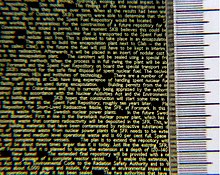Memory of Mankind
Memory of Mankind (MOM) is a project initiated by Martin Kunze in 2012, which aims to provide information from today's time to later "generations, cultures or even civilizations" by means of printed ceramic panels.
method
The information such as texts and images are applied to two different types of ceramic boards (called Level1 and Level2 boards ) and are intended to serve as a time capsule in a clay box . The boards are categorized using catalog numbers, language abbreviations and categories (e.g. private ). In order to ensure readability in the future, an extensive picture dictionary and language-theoretical texts are enclosed with the information .
The MOM project collects:
| Type of information | Examples |
|---|---|
| General and automatically collected content | Editorials of magazines, blogs, Facebook profiles, important books |
| Specific content | Information that comes from MOM's collaborations with other projects or institutions, for example
|
| Individual content | Wedding photos, theses, recipes, poems, ... |
Level1 boards
With the Level1 boards , texts and images are printed with four ceramic color pigments using laser printing on paper coated with gelatine , which is then burned at 850 ° C on the 20 × 20 cm boards. The resolution is around 300 dpi . They should be able to carry up to 50,000 characters with a resistance to heat up to 1200 ° C, chemicals, radiation, magnetism and pressure and weigh 600 g .
Level2 boards
In contrast to the Level1 tables, Level2 boards display the information on a greatly reduced scale, which means that they have a larger storage capacity. However, the content can still be read in analog form using a magnifying glass . They should be able to carry up to 5,000,000 characters engraved on the boards, but only offer space for black and white content. They are also 20 × 20 cm in size, 150 g in weight and are resistant to heat up to 1400 ° C, acids , alkalis , pressure and electromagnetic radiation .
Repository
The ceramic panels are kept in ceramic boxes inside a salt mine in Hallstatt , Austria . There are suitable framework conditions: The salt on the walls dries out the air and also has properties similar to plasticine , which allows cracks to be closed again.
The token
A so-called token 'mark' with a diameter of 6.5 cm shows the position of the archive by means of a crosshair. In addition to the coastlines of Europe, it also shows an outline of Lake Hallstatt with the exact location of the entrance.
Cooperations
- Swedish Atomic Energy Agency
- Kunsthistorisches Museum in Vienna (e.g. an image of the Rosary Madonna by Caravaggio is stored )
- Natural History Museum Vienna (stored e.g. blue swimming crab )
See also
- Commons : Memory of Mankind - collection of pictures, videos and audio files
- Culture of remembrance
- Rosetta project
Web links
- German website memory-of-mankind.com
Documentation
- Ö1 , Dimensions, January 30, 2018: Knowledge for Eternity
Individual evidence
- ↑ a b c d Official website before processing ( Memento from April 4, 2018 in the Internet Archive )
- ↑ a b c David Hesse: Archive of human history - pottery for posterity . In: Süddeutsche Zeitung . April 27, 2017, ISSN 0174-4917 ( sueddeutsche.de ).
- ↑ Eckart Granitza: Memory of Mankind: Ceramic panels better than USB sticks and hard drives. In: rp-online.de. October 23, 2013, accessed June 12, 2018 .
- ^ MOM - Memory of Mankind in Hallstatt. hallstatt.net, accessed June 5, 2018 .
- ^ Richard Kemeny: All of Human Knowledge Buried in a Salt Mine. The Atlantic, January 9, 2017, accessed June 5, 2018 .
- ^ Richard Gray: The world's knowledge is being buried in a salt mine. BBC , October 18, 2016, accessed June 5, 2018 .
- ↑ Markus Rohrhofer: Ceramic plates in the Salzberg: Securing data for a thousand years - derStandard.at. In: derstandard.at. DER STANDARD, June 21, 2016, accessed June 12, 2018 .
- ↑ Knowledge for Eternity from Austria 1 on oe1.arf.at



